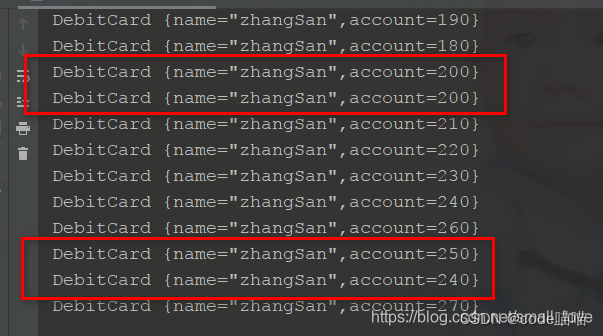通过对 AtomicInteger、AtomicBoolean 和 AtomicLong 分析我们发现,这三个原子类只能对单个变量进行原子操作,那么我们如果要对多个变量进行原子操作,这三个类就无法实现了。那如果要进行多个变量进行原子操作呢?操作方式就是,先把 多个变量封装成一个类,然后通过 AtomicReference 进行操作。
众所周知,对象的引用其实是一个4字节的数字,代表着在JVM堆内存中的引用地址,对一个4字节数字的读取操作和写入操作本身就是原子性的,通常情况下,我们对对象引用的操作一般都是获取该引用或者重新赋值(写入操作),我们也没有办法对对象引用的4字节数字进行加减乘除运算,那么为什么JDK要提供AtomicReference类用于支持引用类型的原子性操作呢?
1、AtomicReference的应用场景
这里通过设计一个个人银行账号资金变化的场景,逐渐引入AtomicReference的使用,该实例有些特殊,需要满足如下几点要求。
个人账号被设计为不可变对象,一旦创建就无法进行修改。
个人账号类只包含两个字段:账号名、现金数字。
为了便于验证,我们约定个人账号的现金只能增多而不能减少。
根据前两个要求,我们简单设计一个代表个人银行账号的Java类DebitCard,该类将被设计为不可变。
public class DebitCard {
private final String name;
private final int account;
public DebitCard(String name, int account) {
this.name = name;
this.account = account;
}
public String getName() {
return name;
}
public int getAccount() {
return account;
}
@Override
public String toString() {
return "DebitCard {name=\""+name+"\"," +
"account="+account+"}";
}
}1.1、通过 volatile 修饰的多线程
public class AtomicReferenceDemo1 {
// 定义为 volatile 修饰的变量
volatile static DebitCard debitCard = new DebitCard("zhangSan", 10);
public static void main(String[] args) {
IntStream.range(0, 10).forEach(i -> {
new Thread(() -> {
while (true){
// 读取全局的 debitCard 对象
final DebitCard debitCard1 = debitCard;
// 基于全局的 debitCard 加10构建一个新的对象
DebitCard newDc = new DebitCard(debitCard1.getName(), debitCard1.getAccount() + 10);
// 把新建的都行赋值给 全局的变量
debitCard = newDc;
System.out.println(newDc);
try {
TimeUnit.SECONDS.sleep(ThreadLocalRandom.current().nextInt(20));
} catch (InterruptedException e) {
e.printStackTrace();
}
}
}, "T-" + i).start();
});
}
}
根据运行结果我们发现,出现了两处存在问题的地方(上图标红的地方),这个是什么造成的呢?这就涉及到我们之前讲过的,虽然被 volatile 关键字修饰的变量每次更改都可以立即被其他线程看到,但是我们针对对象引用的修改其实至少包含了如下两个步骤,获取该引用和改变该引用 每一个步骤都是原子性的操作,但组合起来就无法保证原子性了。
1.2、通过加锁的多线程
针对上面的问题,我们首先想到的可能是通过加锁(synchronized 或 Lock )解决,如下代码所示:
// 加 锁 操作
synchronized (AtomicReferenceDemo1.class) {
// 读取全局的 debitCard 对象
final DebitCard debitCard1 = debitCard;
// 基于全局的 debitCard 加10构建一个新的对象
DebitCard newDc = new DebitCard(debitCard1.getName(), debitCard1.getAccount() + 10);
// 把新建的都行赋值给 全局的变量
debitCard = newDc;
System.out.println(newDc);
try {
TimeUnit.SECONDS.sleep(ThreadLocalRandom.current().nextInt(10));
} catch (InterruptedException e) {
e.printStackTrace();
}
}1.3、 AtomicReference的非阻塞解决方案
第2小节中的方案似乎满足了我们的需求,但是它却是一种阻塞式的解决方案,同一时刻只能有一个线程真正在工作,其他线程都将陷入阻塞,因此这并不是一种效率很高的解决方案,这个时候就可以利用 AtomicReference 的非阻塞原子性解决方案提供更加高效的方式了。
public class AtomicReferenceDemo1 {
static AtomicReference<DebitCard> ref = new AtomicReference(new DebitCard("zhangSan", 10));
public static void main(String[] args) {
IntStream.range(0, 10).forEach(i -> {
new Thread(() -> {
while (true){
DebitCard debitCard = ref.get();
DebitCard newDc = new DebitCard(debitCard.getName(), debitCard.getAccount() + 10);
if(ref.compareAndSet(debitCard, newDc)){
System.out.println(Thread.currentThread().getName() + " 当前值为: " + newDc.toString() + " " + System.currentTimeMillis());
}
long sleepValue = (long) (Math.random() * 10000);
try {
Thread.sleep(sleepValue);
} catch (InterruptedException e) {
e.printStackTrace();
}
}
}, "T-" + i).start();
});
}
}2、AtomicReference的基本用法
2.1、创建 AtomicReference
AtomicReference是一个泛型类,它的构造与其他原子类型的构造一样,也提供了无参和一个有参的构造函数。
AtomicReference():当使用无参构造函数创建AtomicReference对象的时候,需要再次调用set()方法为AtomicReference内部的value指定初始值。
AtomicReference(V initialValue):创建AtomicReference对象时顺便指定初始值。
2.2、常用方法
- compareAndSet(V expect, V update):原子性地更新AtomicReference内部的value值,其中expect代表当前AtomicReference的value值,update则是需要设置的新引用值。该方法会返回一个boolean的结果,当expect和AtomicReference的当前值不相等时,修改会失败,返回值为false,若修改成功则会返回true。
- getAndSet(V newValue):原子性地更新AtomicReference内部的value值,并且返回AtomicReference的旧值。
- getAndUpdate(UnaryOperator<V> updateFunction):原子性地更新value值,并且返回AtomicReference的旧值,该方法需要传入一个Function接口。
- updateAndGet(UnaryOperator<V> updateFunction):原子性地更新value值,并且返回AtomicReference更新后的新值,该方法需要传入一个Function接口。
- getAndAccumulate(V x, BinaryOperator<V> accumulatorFunction):原子性地更新value值,并且返回AtomicReference更新前的旧值。该方法需要传入两个参数,第一个是更新后的新值,第二个是BinaryOperator接口。
- getAndAccumulate(V x, BinaryOperator<V> accumulatorFunction):原子性地更新value值,并且返回AtomicReference更新前的旧值。该方法需要传入两个参数,第一个是更新后的新值,第二个是BinaryOperator接口。
- accumulateAndGet(V x, BinaryOperator<V> accumulatorFunction):原子性地更新value值,并且返回AtomicReference更新后的值。该方法需要传入两个参数,第一个是更新的新值,第二个是BinaryOperator接口。
- get():获取AtomicReference的当前对象引用值。
- set(V newValue):设置AtomicReference最新的对象引用值,该新值的更新对其他线程立即可见。
- lazySet(V newValue):设置AtomicReference的对象引用值。lazySet方法的原理已经在AtomicInteger中介绍过了,这里不再赘述。
3、AtomicReference的内幕
在AtomicReference类中,最关键的方法为compareAndSet(),下面来一探该方法的内幕。
AtomicReference中的方法
public final boolean compareAndSet(V expect, V update) {
return unsafe.compareAndSwapObject(this, valueOffset, expect, update);
}Unsafe中的代码
public final native boolean compareAndSwapObject(Object var1, long var2, Object var4, Object var5);import java.util.concurrent.atomic.AtomicReference;
public class Main {
public static void main(String[] args) {
AtomicReference<String> atomicRef = new AtomicReference<>("Hello");
String oldValue = atomicRef.get();
System.out.println("Old Value: " + oldValue);
atomicRef.set("World");
String updatedValue = atomicRef.get();
System.out.println("Updated Value: " + updatedValue);
boolean exchanged = atomicRef.compareAndSet("World", "Hello");
System.out.println("Exchange Result: " + exchanged);
String finalValue = atomicRef.get();
System.out.println("Final Value: " + finalValue);
}
}输出结果:
Old Value: Hello
Updated Value: World
Exchange Result: true
Final Value: Hello4.AtomicBoolean
// 无参构造AtomicBoolean,默认为false
AtomicBoolean ab = new AtomicBoolean();
// 更改失败
assert !ab.compareAndSet(true, false);
// ab.get()==false
assert !ab.get();
// 更改成功
assert ab.compareAndSet(false, true);
// 更改后的值为true
assert ab.get();























 8582
8582











 被折叠的 条评论
为什么被折叠?
被折叠的 条评论
为什么被折叠?








